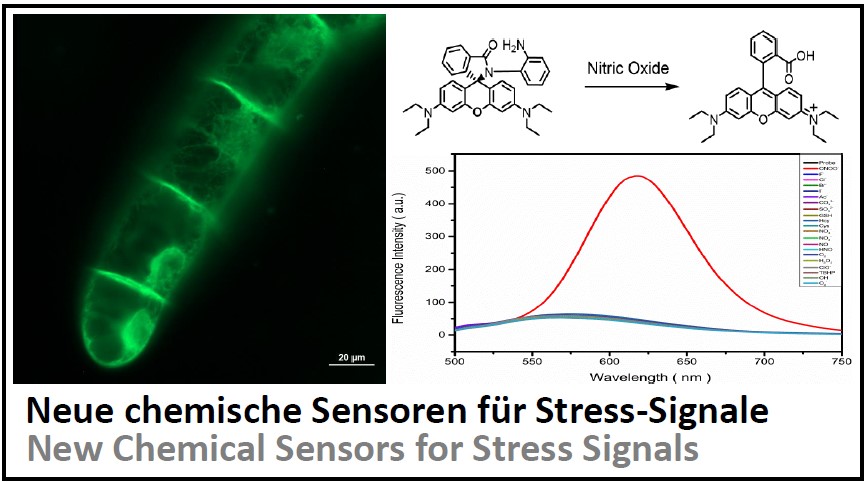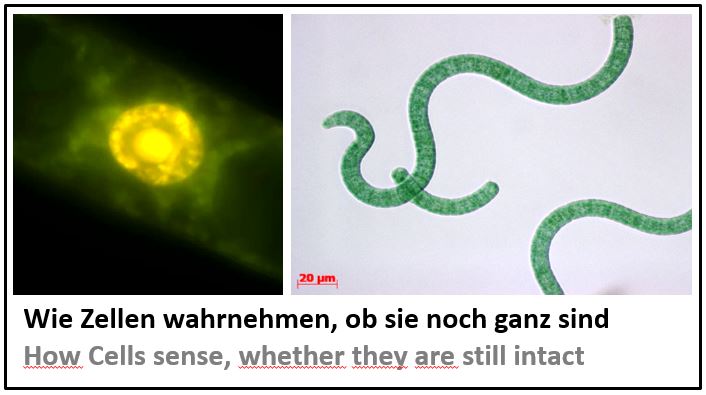 Plant Cell Biology 2024
Plant Cell Biology 2024
Plants cannot run away. Therefore, a neural system able to respond within milliseconds, is not meaningful for plants. Instead, they use chemical signals to sense challenges (stress) and respond by developmental and metabolic adaptation. The complexity of stress responses is amazing - not only can plants differentiate between different qualities of stress, but they can also adjust their response to the details - is the stress short and strong, or is it more a chronic problem, is it coming alone, or together with other stresses? How do they do it - without a brain? We think that stress signalling in plants is a kind of chemical language with rules where combination of signal mean something else then a given signal alone (signature concept of stress. To decipher these rules is comparable to understanding the grammar of human language. To really understand this, it is not sufficient to measure, which genes are activated by a particular stress situation. We need to follow early stress signals and understand, where and when they occur in the cell and how their spatial and temporal pattern depends on the quality, timing, and context of stress. In cooperation with Prof. Dr. Ye from Zhengzhou University in China, we are currently exploring a new generation of fluorescent sensors for important stress signals. The principle of these sensors is that they are non-fluorescent in the medium and can pass through the plasma membrane into the cytoplasm. When they encounter their particular target signal, such as NO, an important but little understood stress signal, they will undergo conformational change leading to formation of a conjugated double bond system capable of fluorescence. The project will explore the use and behaviour of these tools in tobacco BY-2 cells, possibly also in grapevine cells. The work will combine stress physiology, confocal microscopy and quantitative image analysis. Background: review on the stress signature concept [63] Nick P (2023) Towards a Grammar of Plant Stress – Modular Signalling Conveys Meaning. Theor Exp Plant Physiol. doi 10.1007/s40626-023-00292-2 - pdf
Wahrnehmung von Integrität
>>>>>PLANT CELL BIOLOGY OCTOBER 2021: SCRIPT and Manuscript on the background pdf
 |
Worum geht es?
Wenn sich Zellen zu einem Organismus zusammenschließen, ändert sich ihr Verhältnis zueinander dramatisch: aus der Konkurrenz der Einzelnen um Ressourcen und Überleben wird die Kooperation aller. Das eindeutigste Zeichen einer vollzogenen Selbstorganisation ist das Opfer einer einzelnen Zelle zum Wohle des Ganzen. Dieser sogenannte programmierte Zelltod findet sich bei allen vielzelligen Organismen, Vorstufen davon jedoch auch bei einzelligen Algen. Wenn eine Zelle feststellt, dass sie beschädigt ist, hört sie auf, sich zu teilen und leitet den programmierten Zelltod ein. Dies stellt sicher, dass ein Organismus genetisch intakt und damit überlebensfähig bleibt. Für die Zelle selbst ist das natürlich ein Nachteil - sie selbst hat ja nichts von ihrem Opfer. Wenn eine Zelle zum Egoismus des Einzeldaseins zurückkehrt und sich munter weiter teilt, obwohl sie beschädigt ist, entsteht Krebs. Krebs kommt bei Pflanzen nicht vor. Unterscheiden sie sich darin, wie sie ihre eigene Integrität wahrnehmen? Der Actin-Membran-Sensor
Wir konnten zeigen, dass das Actinskelett an der Innenseite der Zellmembran für die Einleitung des programmierten Zelltods wichtig ist. Bei uns ist Actin im Verbund mit Myosin für die Muskelbewegung verantworlicht. Bei Pflanzen scheint Actin eher eine Art Sinnesorgan zu sein. Selbst kurze Störungen der Membranintegrität lösen eine schnelle Reaktion von Actin aus, die vermutlich den Einstieg in den zellulären Selbstmord darstellt. Neben chemischen Trojanern benutzen wir auch hochenergetische, aber extrem kurze (im Nanosekundenbereich) elektrische Impulseum diese Reaktion auszulösen und daran zu verstehen, wie die Zelle eigentlich in der Lage ist, ihre Integrität wahrzunehmen. Neben dem Actinskelett ist ein membranständiges Enzyme, die NADPH Oxidase, an der Wahrnehmung von Integrität beteiligt. Dieses Enzym erzeugt aus Superoxid-Anionen, eine besondere Form von reaktiven Sauerstoffspezies. Wird die Integrität gestört, dringen diese Anionen in die Zelle ein und aktivieren ein G-Protein, das wiederum Phospholipase D aktiviert, einen wichtigen Knotenpunkt der Signalverarbeitung. Wir sind noch weit davon entfernt, diesen Actin-Membran-Sensor wirklich zu verstehen, aber wir haben inzwischen herausgefunden, dass Integrität über einen Fluss von Signalen durch dieses Sensorsystem gemessen wird - solange es fließt, signalisiert dieses System der Zelle, dass alles in Ordnung ist, in dem Augenblick, da der Fluss stockt, wird die Zellteilung angehalten.
Einzelprojekte
|
